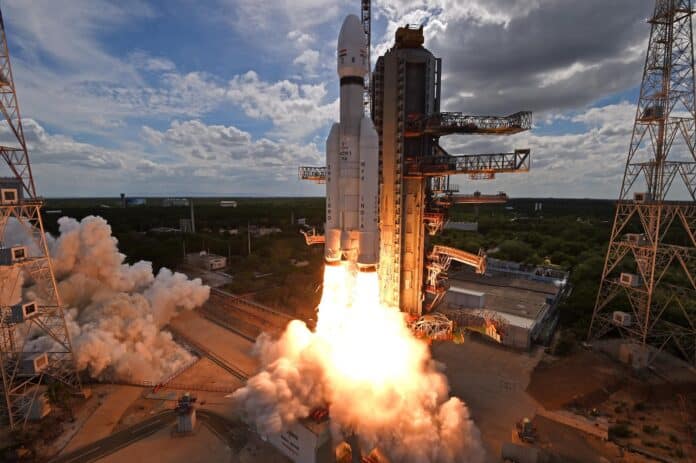On July 14, 2023, ISRO launched its ambitious third lunar mission Chandrayaan 3, at 2.35 PM IST from SDSC SHAR, Sriharikota. The mission’s successful launch marks a proud moment for the country, India, and is a significant milestone in space exploration.
The Chandrayaan-3 took off in the fourth operational mission (M4) of the LVM3 launcher. As the mission is a follow-on mission to Chandrayaan-2, this time, ISRO is looking forward to demonstrating a soft landing on the lunar surface by its lunar module and demonstrating roving on the lunar terrain.
Chandrayaan-3 consists of a lander module (LM), a rover, and an indigenous propulsion module (PM) to develop and showcase new technologies for interplanetary missions.
The propulsion module propels the Lander and rover configuration up to a 100-kilometer lunar orbit. To examine Earth’s spectral and Polarimetric data from the lunar orbit, the propulsion module is equipped with the Spectro-Polarimetry of Habitable Planet Earth (SHAPE) payload.
The Lander will be able to soft-land at a specified location on the moon and release the Rover, which will conduct an in-situ chemical analysis of the lunar surface while it is moving. There are scientific payloads on the Lander and the Rover that will conduct lunar surface experiments.
The primary objective of PM is to transport the LM from injection into the launch vehicle to the final 100 km circular polar orbit of the moon and then to release the LM from the PM. In addition to this, the Propulsion Module carries a scientific payload that will operate when the Lander Module separates. LVM3 M4 has been identified as the launch vehicle for Chandrayaan-3, and it will deposit the integrated module in an Elliptic Parking Orbit (EPO) with a dimension of approximately 170 x 36500 km.
To achieve the mission objectives, several advanced technologies are present in Lander, such as,
- Altimeters: Laser & RF based Altimeters
- Velocimeters: Laser Doppler Velocimeter & Lander Horizontal Velocity Camera
- Inertial Measurement: Laser Gyro based Inertial referencing and Accelerometer package
- Propulsion System: 800N Throttleable Liquid Engines, 58N attitude thrusters & Throttleable Engine Control Electronics
- Navigation, Guidance & Control (NGC): Powered Descent Trajectory design and associate software elements
- Hazard Detection and Avoidance: Lander Hazard Detection & Avoidance Camera and Processing Algorithm
- Landing Leg Mechanism.
Specifications:
- Lunar Polar Orbit: From 170 x 36500 km to the lunar polar orbit
- Mission life: Carrying Lander Module & Rover up to ~100 x 100km launch injection. Subsequently, the operation of the experimental payload for a period of 3 to 6 months.
- Structure: Modified version of I-3 K
- Dry Mass: 448.62 kg (including pressurant)
- Propellant Mass: 1696.39 kg
- Total PM Mass: 2145.01 kg
- Power Generation: 738 W, Summer solistices and with bias
- Communication: S-Band Transponder (TTC) – with IDSN
- Attitude Sensors: CASS, IRAP, Micro star sensor
- Propulsion System: Bi-Propellant Propulsion System (MMH + MON3)
Lander Payloads:
- Radio Anatomy of Moon Bound Hypersensitive Ionosphere and Atmosphere (RAMBHA): To measure the near-surface plasma (ions and electrons) density and its changes with time.
- Chandra’s Surface Thermo Physical Experiment (ChaSTE): To measure the lunar surface’s thermal properties near the polar region.
- Instrument for Lunar Seismic Activity (ILSA): To measure seismicity around the landing site and delineate the lunar crust and mantle structure.
- LASER Retroreflector Array (LRA): It is a passive experiment to understand the dynamics of the Moon system.
Rover Payloads:
- LASER Induced Breakdown Spectroscope (LIBS): Qualitative and quantitative elemental analysis & To derive the chemical Composition and infer mineralogical composition to further our understanding of the Lunar surface.
- Alpha Particle X-ray Spectrometer (APXS): To determine the elemental composition (Mg, Al, Si, K, Ca, Ti, Fe) of Lunar soil and rocks around the lunar landing site.
Propulsion Module Payload:
- Spectro-polarimetry of HAbitable Planet Earth (SHAPE): Future discoveries of smaller planets in reflected light would allow us to probe into various Exo-planets that would qualify for habitability (or for the presence of life).
ISRO chief S Somanath on Chandrayaan-3 said, “If everything goes normal then landing on the moon is expected on August 23rd at around 5.47pm IST.”
